Narcissus Flycatchers: notes on their Identification and Status
Arranged and edited by Charlie Moores

Here from left to right: Adult male narcissina, April, Korea, © Nial Moores; Adult male zanthopygia, April, Korea, © Nial Moores; Adult male owstoni, "summer", Amami-Oshima, Japan, © Pete Morris / Birdquest; Adult male elisae, February, Malaysia, © Tun Pin Ong.
Introduction
Among Ficedula in Far East Asia, the adult males of four taxa share a beautiful and striking plumage combination: a broad, vividly colored rump-band more or less matching much of the underparts in tone and intensity. In the three taxa generally considered to belong to Narcissus Flycatcher, this rump band is either orangey-amber (narcissina), amber-yellow (owstoni) or lemon-yellow (elisae), while in the rather similar Yellow-rumped Flycatcher F. zanthopygia it is an intense daffodil-yellow, tinged very faintly greener.
In addition while all four have a dark tail and remiges, with a white “wing-patch” of varying prominence, two have a crown and mantle that is black (zanthopygia and narcissina) and two have a crown and mantle that is green (elisae and owstoni).
A combination of factors has led, however, to there being very little easily-accessible information on other significant differences, most especially between the three (sub-) species of Narcissus Flycatcher. In Korea at least (and likely throughout much of the region) this lack of information has prevented the confident identification of a number of individuals, including two Second Calendar-year males on Gageo Island in April 2001, and several other female-types, most recently including one photographed on Heuksan Island in April 2005. Additionally, it has likely discouraged research on owstoni; has undermined region-wide acceptance of elisae as a full species; and has apparently contributed to the confusion over the newly-described “Beijing Flycatcher F. beijingnica” (here considered synonymous with elisae).
Considering both the likely threatened status of elisae and owstoni and their claimed occurrence in Korea, this online paper therefore aims to present information on narcissina, elisae, owstoni and on F. zanthopygia, gathered through personal observation, website-based research and direct mailing to experienced observers.
As a result of this process (and in the assumption that no other narcissus-type taxon remains undescribed in the region), it has become possible to propose a clearer, though still incomplete, set of identification criteria (listed in table-form in the Appendix below the References), and to highlight several significant differences between these taxa. While elisae is already often considered a potential split from narcissina (as Green-backed or Chinese Flycatcher) it is also apparent that - even based on limited study – owstoni also requires taxonomic review. As well as obvious differences in adult male plumages, narcissina, owstoni and elisae have different ranges and migration strategies (with narcissina breeding on the four main islands of Japan, wintering south to the Philippines and Borneo; owstoni believed breeding only in the Nansei Shoto between Taiwan and Kyushu, with its southern populations resident; and elisae breeding locally in hill forests in Eastern China, wintering mainly in northern Malaysia and southern Thailand); all three show likely consistent differences in female-type plumages (though on present knowledge, perhaps not all female-types are safely identifiable); all likely show consistent differences in biometrics; and apparently all three of the taxa have different songs.
As a detailed taxonomic status review is clearly beyond the scope and purpose of this online paper, it aims instead:
To encourage discussion on the status and distribution of narcissina, owstoni and elisae;
To outline identification criteria for each taxon, while providing further details and documentation on the owstoni and elisae observed in Korea; and
To highlight presumed gaps that remain in present knowledge.
Although it has already benefited enormously from input by birders throughout the ranges of these taxa (please see Acknowledgments below), it clearly still remains far-from comprehensive. Confirmation of several of the plumage-based identification features and information on biometrics, aging, sexing, variation in vocalizations and population estimates remain lacking. As always, therefore, we continue to welcome further images and information so that this online paper can take full advantage of contemporary technology - and be revised and improved over time.
Status and Distribution
Several of the most widely-used field guides of the region (i.e. WBSJ, 1982; Mackinnon and Phillipps, 2000; Lee, Koo and Park, 2000) map the Narcissus Flycatcher as a species with a breeding range covering much of Japan (from Hokkaido south through the Nansei Shoto), with an additional discrete breeding population in Eastern China. None of the three, however, refer to owstoni by name, and only Mackinnon and Phillipps describes elisae. Information on the distribution of the three (sub-) species contained in Robson (2000) and especially in Brazil (1991), Otani (2002), and Holt (2004), however, reveals that although breeding of these three taxa is indeed confined to Japan and China, none overlap - either in their breeding or wintering ranges.
Indeed, apart from during migration, of the four taxa considered in this paper it is only the comparatively widespread Yellow-rumped Flycatcher (which nests through the Korean peninsula, in parts of Eastern China and in much of the Russian Far East) and the very local elisae that appear to overlap at all regularly.
The following section aims therefore to provide rather more information on the distribution and status of the three “narcissus-type” taxa (with special reference to Korea), before outlining identification criteria in much greater detail, including some further description of zanthopygia.
Narcissina
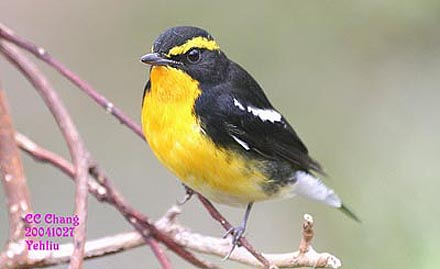
Photo © Chuan-Chiung Chang. In non-breeding plumage, the intensity of orange tones, e.g. on the throat, can appear much reduced.
Narcissina is apparently both the most numerous and the best-known of the three “narcissus-type” taxa, breeding north to Sakhalin (Robson, 2000), and being described as a “common and widespread summer visitor to Shikoku, central and northern Honshu and Hokkaido…less common in Kyushu and Tsushima” (Brazil, 1991). It breeds in often dense and sometimes damp forest (pers. obs.), up to 1800 m in Japan, and “even up to the sub-alpine evergreen zone” in Honshu (Brazil, 1991). In Okinawa Prefecture (including the Nansei Shoto), however, it has been described as only a “rare migrant” (Mc Whirter et al, 1996).
Narcissina winters well to the south of its breeding range. It typically appears to be absent from Japan in mid-winter; Chalmers (1986) gives only one winter record of narcissina for Hong Kong (December 22, 1969); Mackinnon and Phillipps (2000) state that some winter in Hainan; while Robson (2000) states that it winters in Borneo and the Philippines. In the Philippines, however, it is said to be rarely encountered by birders (Des Allen in lit., 2005).
In spring, narcissina is a scarce migrant in Hong Kong (suggesting regular wintering to the south of there), with most records being of adult males (Chalmers, 1986; online Checklist of Hong Kong Birdwatching Society). In Taiwan, it is a “rare migrant” (Wayne Hsu, in lit., 2005), with most internet images from Taiwan being of males (perhaps suggesting at least some females are overlooked), while on the East coast of China, a total of 4 were recorded between April 21st and May 5th 2005 on islands east of Shanghai (Bo Petersson et al unpublished report, 2005) - rather fewer than noted on South Korean islands during the same period. It has also been recorded at the northern end of the Yellow Sea in Hebei Province e.g. at Happy Island, though appears to be very rare there (e.g. Mathias Ritschard in lit., 2005).
In South Korea, it is a regular spring migrant, with most records in the southwest islands and fewer along the south coast (occurring annually in Busan, for example). First arrivals usually occur in the second week of April (e.g. April 12th, 2002; April 10th, 2005: pers. obs.) with peak day counts of 30 or 40 individuals recorded some years (e.g. on Heuksan, Gageo and Eocheong Islands), typically in late April and early May, and invariably following periods of inclement weather. Rather smaller numbers are found further north – with for example an exceptional peak of 12 males on Socheong Island on May 3rd, 2004 (Klemens Steiof in lit., 2004).
Southward migration in Japan appears to be rather more protracted and with much variation, with some birds apparently leaving breeding areas in Hokkaido in August, others remaining there until October, and some still lingering into mid-November in mid-Honshu (Brazil, 1991; Brazil in lit., 2005). Based on personal observations, it appeared to be much scarcer in autumn than in spring in Fukuoka, northern Kyushu between 1990 and 1997. Although singing males were present in some areas through May and June and some cases even into July, none could be found in the same areas in August.
In South Korea, it is recorded probably scarcely annually along the south coast or on the southwest islands, typically in October. At least until 1986, there had been no autumn records in Hong Kong (Chalmers, 1986).
As narcissina is generally a rather skulking taxon, often found in dense and heavily shaded forest, it is much more easily heard than seen, either in breeding areas or to a lesser extent on migration (pers. obs). It is therefore unclear whether the paucity of autumn records in e.g. South Korea is due more to a significant difference in migration strategy (for example with most moving, post-breeding, down through Japan before southward migration, thus “missing” Korea and even Japan’s Nansei Shoto), or due to birds being much more secretive and avoiding detection in the autumn.
Although said by Mackinnon and Phillipps (2000) to migrate “through E and S China and Taiwan”, based on spring records, narcissina appears to be considerably more numerous on migration in areas to the east rather than to the west of an approximate north-south line drawn from the Philippines through southwest Japan and South Korea and on to Sakhalin.
Being a long-range migrant that leap-frogs the short-distant migrant owstoni, and has a main migration route lying to the east of the Asian continental land mass, it is perhaps not so surprising that it has occurred both as a vagrant south to Australia (first in November 1996, see http://users.bigpond.net.au/palliser/barc/sub259.html) and north to Alaska (one or two records as of January 1st, 2005: see http://www.uaf.edu/museum/bird/products/checklist.pdf)
Owstoni
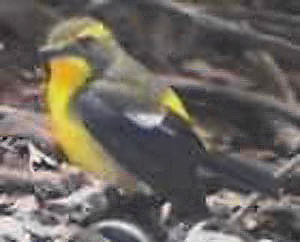
Present for several days at this site, its identification is based on its green crown and mantle (contrasting with the darker flight feathers), apparently long supercilium reaching to the bill base, bi-colored ear coverts, lack of orange on the throat, and white ‘spur’ on the lowest tertial.
The little-known owstoni has a much more restricted distribution than narcissina, with breeding believed confined to the Nansei Shoto, a long, curving arc of Japanese islands lying between the main island of Kyushu (Japan) and Taiwan. Long considered a “resident” endemic subspecies (e.g. Brazil, 1991), it has been seldom described in either field-guides or in the birding literature, increasing greatly the possibility of its being overlooked away from core breeding areas. Rather more recently, Otani (2002) considered that although the true status of owstoni still remains largely “unclear”, it was now believed to occur on islands from Iriomote in the south, to Tanegashima (just south of Kyushu) in the north, a range spanning approximately 1 000 km. Additionally, in the north of its limited range it is now known to be largely/entirely a summer visitor, with smaller, shorter-winged birds presumed resident in the south (Otani, 2002). Previously, taxonomic arrangements recognized two further subspecies within the same archipelago: jakuschima from Yakushima (to the north of the archipelago) and shonis from Amami Oshima (towards the center). Both were later considered synonymous with owstoni (see e.g. Morioka et al, 2005), but still also suggest that the geographical variation in owstoni is worth further investigation.
Owstoni is apparently most numerous in subtropical evergreen forest, but can also be found occasionally in remnant forest patches, in dense cover in degraded secondary forest and sometimes at more open forest edge (e.g. Fergus Crystal, in lit. 2004; Sean Minns, in lit., 2004). Birds Korea has not yet been able to trace population estimates, but it appears to be rather scarce, and considering the extent of habitat loss and degradation on many of the islands, it is most likely of Special Conservation Concern. According to Brazil (1991) owstoni was formerly described as “common…at very low altitudes” but subsequently had “become very uncommon on Amami-Oshima and Okinawa…no birds were heard on territory for several years in the mid-1980s”. Otani (2002) also states that “the population is thought to be small; it is restricted to small islands and at least on Amami-Oshima, Okinawa, Ishigaki and Iriomote… its density is not high”. In contrast perhaps, in 2004 no less than 50 singing males in total were estimated heard along a route taken between Ohara and Uehara on Iriomote, between March 25th and 26th (Fergus Crystal in lit., 2004).
As owstoni is not a sedentary taxon - but rather a short-range migrant in the north of its range – it is only to be expected that it will occasionally be recorded away from the Nansei Shoto. It has, for example, been recorded in Taiwan (Fig. 3), in Kyushu (see Figs.23-27 in identification section below), and at least once in western Honshu, with a Second Calendar-year male photographed in Masuda City, Shimane Prefecture on May 2nd, 1999 (Ishimoto, 2005).
More surprisingly, however, owstoni has also strayed to South Korea. Apparently two different Second calendar-year males were photographed in April 2001 on Gageo Island (at approximately 34 D 05 N, 125 D 05 E) - one by Charlie Moores and NM on April 26th, 2001 (Fig. 28-29), with a second individual two or three Km distant and several days apart by Park Jin-Young (Fig. 30). In addition, there have been one or more further probable owstoni noted by NM in South Korea, both green-backed “female-types’: one with yellow specks coming through on the rump (Gageo Island between May 9th and 11th, 2000), and one with yellow-looking, frayed uppertail coverts photographed on Eocheong Island (at approximately 36 D 10 N, 125 D 58 E) on May 10th, 2004 (Fig. 31). Gageo Island (often named So-Heuksan on maps) is approximately 1 000 km due north of Iriomote (across open sea), and at least 500 Km removed from any known breeding islands. It seems possible that these individuals, if correctly identified, could have been drifted north to Korea by strong southerly winds, produced by low-pressure systems tracking west in spring across the East China Sea.
Considering the frequency of such weather systems and the recent records to the north and northeast of its breeding areas, it seems quite possible that owstoni could occur in spring significantly north of its presently mapped breeding range with some regularity - perhaps especially on islands off the west coast of Kyushu and western Honshu, in Korea along the south coast and on the southwest islands, and even northwest to the Chinese coast?
Elisae
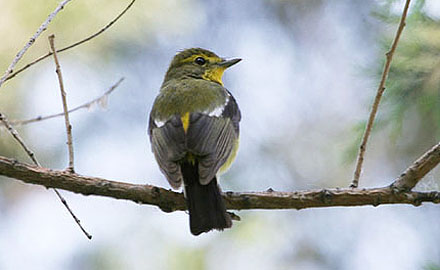
Recent analysis describes elisae as a “rare, very localized north-east Chinese endemic breeder…known to breed at few sites in Hebei and Shanxi. In recent years it has been recorded annually in Hebei at Zushan Forest Park…and Wulingshan, and almost annually as a coastal migrant…There are few records of wintering birds from peninsular Thailand and northern Malaysia and a single record of a presumed migrant bird in Hong Kong” (Holt, 2004). It seems very probable, based on this sketchy account by Paul Holt, that like owstoni, elisae is a taxon of Special Conservation Concern.
In 2005, based on information provided in response to this paper, there was at least one record in Hong Kong (Peter and Michelle Wong); one seen in Beijing (Steve Arlow: see Fig. 4); and several at Happy Island and in regular breeding areas (Mathias Ritschard in lit., 2005). According to descriptions of the breeding habitat near to Beijing of ‘Ficedula beijingnica’ (described as the new species Beijing Flycatcher by Zheng et al, 2000, but treated here as synonymous with elisae), it breeds in hill forest, at altitudes between 800 m to 1400 m above sea-level (Zheng et al., 2000).
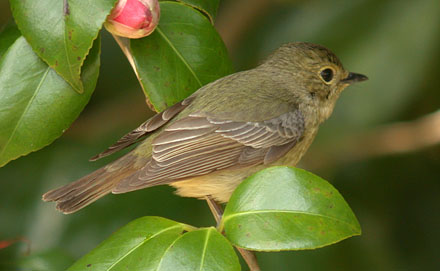
Hueksan Island, South Korea, © Park Jong-Gil.
There have been at least three claims of elisae in South Korea. There was one green-backed male-type and one “very green” female-type – both either owstoni or elisae - in late April 2002, on Eochoeng Island; while further south on Heuksan Island (at approximately 34 D 40 N, 125 D 30 E), there was one female-type on October 10th, 2003, and more recently a presumed First-summer male on April 24th, 2005 (Fig. 5 and Figs 43-44). The latter two records were both formally documented, with the 2005 identification also supported by photographs. Following consultation and on the basis of the 2005 record, elisae has now been accepted onto the Birds Korea checklist, and added to Category 1 as Green-backed Flycatcher Ficedula elisae.
It seems possible, based on these claims and on its migratory status in China, that elisae might prove to be a rare but annual migrant through Korea.
Intriguingly, it also means that the identification of female-type narcissus-type flycatchers in South Korea is perhaps uniquely challenging, with all three taxa recorded, and elisae and owstoni both possible as spring overshoots on southwest islands…
Identification
The adult males of all the region’s Ficedula flycatchers are extremely colourful and rather distinctive, and most of the identification challenge therefore lies in separating “female-types” (all females and immature males). Due to significant differences in the extent of male-type features shown by Second Calendar-years, “female-types” of the taxa under discussion (narcissina, owstoni, elisae and zanthopygia) include First-winter narcissina and zanthopygia; First-winter and some First-summer owstoni; and all First-winter and most Second Calendar-year elisae (this assumption based on pers. obs.; on Otani, 2002; and on Zheng et al., 2000). Due largely to the limited information available, and to lack of discussion on key criteria, it is probably not possible at present to identify all female-types confidently - especially outside of core breeding areas. (Note, however that this is perhaps also true of female-types of several other species of Ficedula in East Asia).
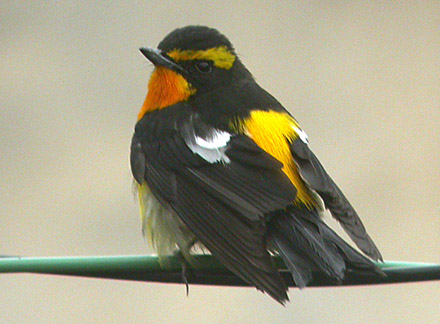
Note the diagnostic combination of black crown and mantle; fiery orange throat; black feathering separating yellow of supercilium from nostril, and the extremely long primary projection beyond longest tertial.
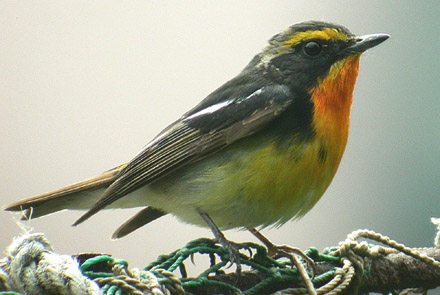
A fairly typical individual. Note the patchy brown on the nape and on the flight feathers, and again the black feathering at the bill base.
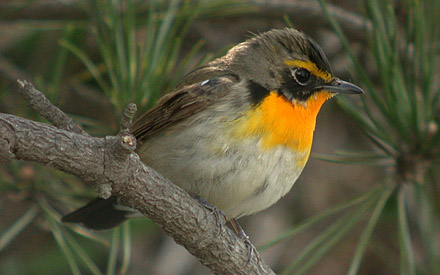
A rather atypical individual, in showing largely white underparts, contrasting with an intensely-colored throat. Note the all dark ear coverts and black feathering at bill base considered diagnostic of narcissina.
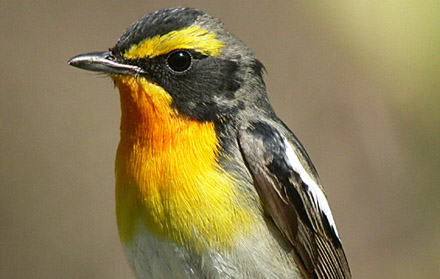
Heuksan Island. © Nial Moores
Narcissina
Although detailed biometric data were not accessed during the writing of this paper, narcissina is slightly larger, and clearly longer-winged than elisae and especially some populations of owstoni. Narcissina shows a very long primary projection beyond the tertials on the closed wing, with often ca 8 or 9 (largely bunched) primary tips visible, in many forming a fairly sharp wing point. The bill is not especially strong, appearing less deep and heavy than the bill of zanthopygia in direct comparison.
Full adult males (at least Third calendar-year onwards) are highly distinctive, with a striking “Blackburnian Warbler-like” combination of black crown, ear coverts, mantle, upper breast sides (and flanks – though usually concealed), tail and flight feathers, contrasting with a fiery orange throat/upper breast (fading more yellowish towards the belly), and additionally an orangey-amber-toned rump/lower back, and supercilium (ending just short of the bill), a variably extensive white wing patch formed largely by the wider and longer inner greater coverts and a white/whitish lower belly/vent.
Like zanthopygia, Second calendar-year males show many features suggesting full adults (at least by April), though with a rather more extensive and variable amount of brown mottling than that species – with most typically concentrated on the nape/hindneck, and sometimes on the mantle. Most also have rather worn and contrasting brown wing coverts and flight feathers. Additionally, the yellow on the underparts often appears rather streaky on the belly/vent.
Female-types are somewhat variable, some appearing rather bright and buffy-brown in their first autumn, others appearing very much duller with wear, and many appearing rather worn and faded-looking by spring.
All female-types are believed to lack even a slightly brighter rump-band (unlike some female-type elisae) or any obviously brighter feathers on the rump, and are fairly uniform brownish above (occasionally with an olive tinge, sometimes faintly grayish-buff tinged, and sometimes a little grayer on the crown or nape). The ear coverts are often mottled paler, and a few also show a faint pale ‘mock supercilium’. The tail tends usually to be the strongest coloured part of the bird, being contrastingly rufous/chestnut (diffusely darker distally), as sometimes too are the edges of the remiges on the closed wing. The wing-bars, formed by pale or very pale rusty-brown tips to the median and greater coverts, are not especially distinct (and do not compare in strength to those shown by some elisae). The tips of both inner and outer greater coverts are usually of a similar tone, rusty in fresh First-winters, wearing thinner and paler. The median coverts are dark grey (lacking the complex pattern shown clearly by several images of owstoni), while the tertials are fairly evenly dark with a complete pale fringe, lacking the broader pale tip shown by some owstoni and many elisae in images. The underparts are pale brownish, often rust-toned along the flanks, fading paler ventrally, and with a faintly mottled appearance on the breast (obviously less well-defined than e.g. in zanthopygia and many owstoni at a similar age).
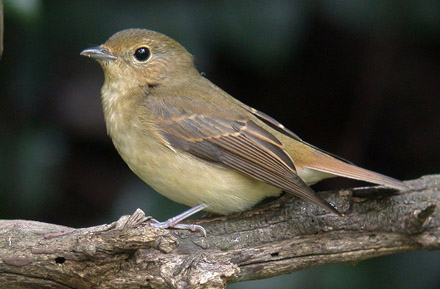
Note the very long primary projection with sharply pointed-looking wing tip; the rather weak mottling on the underparts; the fresh-looking rusty-tipped median and greater coverts; and the two-toned eye-ring, rusty above, paler below.
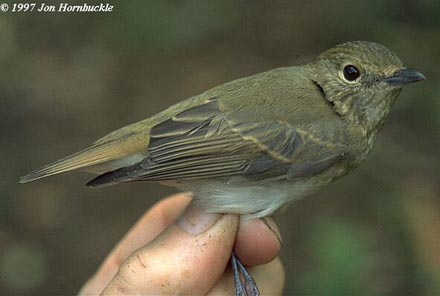
Rather duller than the individual in Fig. 9, and rather greener-toned above, it nonetheless shows similar rusty tips to all the median and greater coverts, a two-toned eye-ring and a long primary projection.
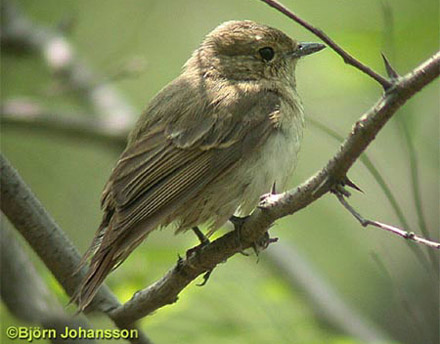
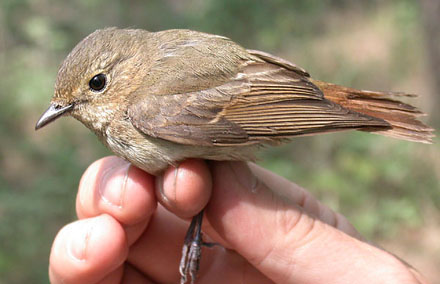
Appearing strikingly different dependent upon the angle of light, worn adult-type females like this individual still usually appear rather brown and beige, with stronger rusty tones apparent in the tail, the edges to the remiges, the tips to the wing coverts, and in the eye-ring.
Personal observations, field guide illustrations and images suggest that female-type narcissina never show any bright yellow tones on the underparts. However, one image of a female-type taken in Japan in May or June (without location, at: http://sinkjpn.web.infoseek.co.jp/be3a6490_rt16an7.jpg), shows fairly faint but still obvious dirty yellow mottling on the lower belly, and on the throat.
Significantly, the eye-ring of female-type narcissina is moderately prominent, complete, very often rusty-toned or brown-buff above and a little paler below, occasionally appearing off-white throughout. It never seems to show clear yellow tones, unlike some owstoni and most/all elisae. The bill is all-dark (lacking an obviously paler base), and the legs are very dark grey/blackish.
As all male narcissina (Second Calendar-year onwards) are believed to have assumed a clearly male-type plumage by e.g. mid-April onwards, any female-type in spring showing obviously bright patches on the underparts or upperparts, a strong supercilium or a prominent white wing-bar or wing-patch, will not be narcissina.
Identification Summary: Narcissina
Long primary projection, medium-sized bill, typically appearing all dark/black. Legs typically dark. Male-type plumage suggesting adult male acquired in Second Calendar-year. Full adult males show diagnostic combination of black crown and mantle; black feathering between supercilium and nostril; and in breeding plumage fiery orange tones to throat and sometimes to the rump. Females and (presumably) First Calendar-year males are generally plain, brownish or brownish olive-green above, with fairly weak mottling below, lacking strong yellow tones. The wing-bars are rusty-tipped and the eye-ring is often two-toned, rusty above, paler below.
Owstoni
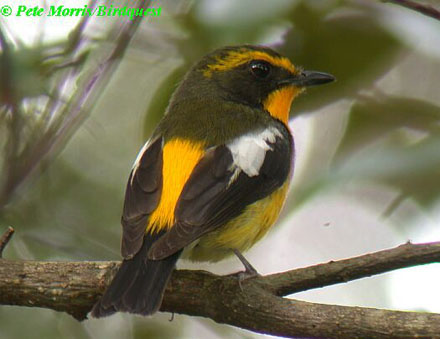
A proper understanding of the appearance of owstoni is hugely complicated by (a) the lack of easily accessible information; (b) individual variation combined with suspected variation north-south across its limited breeding range (which was formerly considered sufficient for there to have been two further subspecies recognized in the same archipelago: Morioka et al, 2005); and perhaps (c) by possible confusion with migrant narcissina, which as Brazil (1991) states has been recorded at least on Amami-Oshima and Ishigaki-Jima (two islands on which owstoni has been reported breeding).
On present knowledge owstoni can be regarded as being somewhat smaller than narcissina and in many ways intermediate in appearance between it and elisae – with many immature birds (especially males?) showing for example obviously mottled, yellow-washed underparts and even a yellowish eye-ring.
Structurally, the primary projection (with apparently between only ca 5 and 7 primary tips visible beyond the longest tertial) appears shorter than in narcissina, elisae or zanthopygia (especially so in more southern birds: Otani, 2002), with images also suggesting more obviously rounded primary tips – both features perhaps indicative of a less migratory nature. Although the bill has been described in the field as “dishy” and “slightly upturned” (Fergus Crystal, in lit 2004.), this does not seem apparent in images. However, the bill does appear marginally heavier and perhaps deeper than that of narcissina, and often slightly paler near the base on the lower mandible. The legs also appear from images to be often rather more blue-grey in tone than in narcissina (though some such tones might be a product of light conditions?).
“Obvious” males
Full adult males (at least Third calendar-year onward), and especially more northerly ones (Akiyo Nakamichi in lit., 2005), can appear superficially similar to narcissina of a similar age. However, all still show several very distinctive differences (with plumage perhaps vaguely suggestive more of a Kentucky Warbler than a Blackburnian!). Most obviously, the black of the mantle, nape and crown is replaced by an olive-green or moss-green of varying intensity (similar to adult male elisae in some specimens shown in Otani, 2002), with some rather more black-green than others (e.g. see Figure 6, P.229 of Ozawa, Yamagata and Yoshino, 2000). Additionally there is some contrast in the ear coverts (greenish to the rear of the eye and below it, blacker further below); the fiery-orange tones of spring and summer narcissina are lacking, being replaced with amber-yellow or yellow (with the throat, however, still often more intensely colored than the rest of the underparts in breeding plumage); and apparently diagnostically, the colour of the supercilium reaches forward to the bill, with yellow feathering close to the nostril (Otani, 2002). The tertials, unlike in narcissina, seem to show some subtle contrast (with greyer-washed inner webs contrasting with darker shading on part of the outer webs). Additionally, in some (mostly the darker individuals?) the white in the wing can appear rather restricted, while in others (especially greener-looking birds?) the white wing patch often extends obviously along the lowest tertial, forming a prominent white ‘spur’ (a key feature shared with zanthophygia).
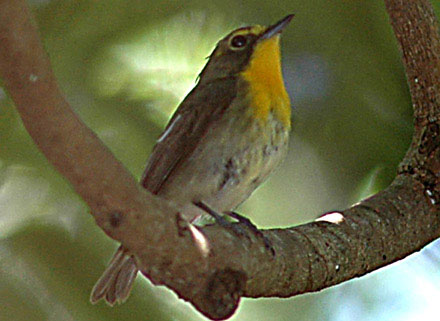
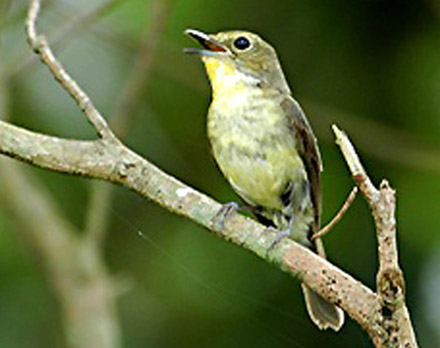
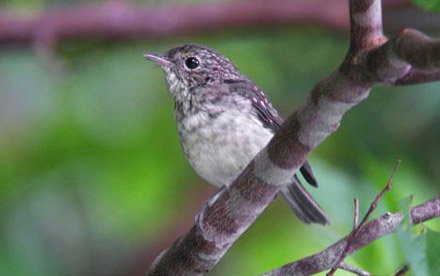
Some Second Calendar-year males reveal similarity to elisae and even more distance from narcissina in apparently not acquiring an obviously adult-male-like plumage. Otani (2002) states: “The moult strategy is also somewhat different to that of F. n. narcissina, in which first summer plumage is similar to the adult plumage, whilst in F. n. owstoni the first summer plumage of the male is similar to the female and some individuals can be seen breeding in the plumage”.
It is clear that although First-summer males are distinctly less advanced than similar-aged narcissina in appearance, there is very great individual or population-level variation, requiring much further study. Otani (2002) states: “The immature male plumage often shows some similarities to F. n. elisae with characters including olive upperparts, yellow rump and throat, white wing patch and short yellow eye-brow”.
Female-types (and immature males)
There appears to be even less information on female-type owstoni (a term used here to describe all females, and also immature males that have yet to develop any obviously- male features), and many might well be confusable with elisae if structural details are not well-seen. Unlike narcissina, many such immature birds (including juveniles) and perhaps even some adult females appear to show heavy brown mottling below (perhaps unlike elisae largely confined to the breast sides), yellow tones of varying intensity on the underparts, and also sometimes rather yellow-toned eye-rings. It seems very useful to consider the progressive changes in female-type plumages through the winter into the spring to help isolate characteristics both of immature males and of females, assisting both with aging and with separation from narcissina and elisae.
As in elisae, there appears to be a gradual intensification of yellow underpart tones from juvenile plumage through the first winter in many males (at least), with the emergence too by March or April of the Second Calendar-year of more obviously male features (such as a distinctive darkening along the moustachial stripe and lower ear coverts, as in Fig.15). It is not apparent, based on the limited information presently available, whether differences by date in the emergence of clearly male-type features is related more to individual variation or to variation between populations. However, two main types of immature male seem to predominate in spring and summer: one, rather elisae-like (lacking extensive dark in the lores, ear coverts or mantle), and the other rather more suggestive of narcissina (with darker ear coverts, intense yellow throat and breast often contrasting with paler belly and vent).
Females, Otani (2002) suggests, “are similar to narcissina but with the upperparts…tinged greenish”; Fergus Crystal (in lit., 2004) noted two out of three female-types seen briefly on Iriomote in March had “greenish-tinted” upperparts (and one was “narcissina-like” brown); while Motokawa was reported as stating that female-types are identical to female-type narcissina (per F. Crystal, 2004).
Although none of these experienced observers suggest that female (-type) owstoni show either obvious yellow on the underparts, or a yellow-toned eye-ring, some of the few images available of female-types appear to reveal both features – making separation of at least some such individuals from narcissina straightforward.
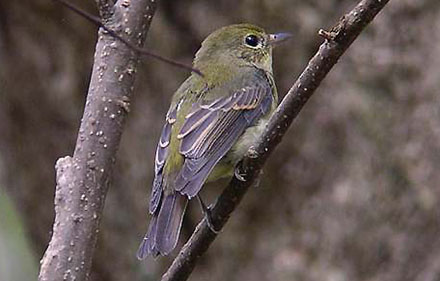
Figure 18, labeled by Aoki san as a “possible owstoni”, reveals an individual very strongly saturated with green on the upperparts, and although the median coverts appear rather disorganized, they also seem to be bi-colored, darker and grayer (two features not obviously shown by female-type narcissina). Additionally, the outer greater coverts are edged broadly rufous-rust, while the inner greater coverts appeared contrastingly paler-tipped (and rather longer and broader). The tertials also appear broadly fringed, with rather more pale-rust/whitish on the tips, forming a blunt, pale tip more obvious than in female-type narcissina (see e.g. Figs 10-13). Some of the tail feathers appear darker than is typical in narcissina, with rusty tones apparently confined largely to the outer web of the tail feathers. The eye-ring is complete and prominent, and although whitish below, is tinged greener above (not yellowish as in elisae, nor rusty as in narcissina). Structurally, the bird appears rather heavy billed (accentuated by some paler tones toward the bill base), and shows rather less primary projection beyond the tertials than narcissina, with obvious blunter-looking primary tips.
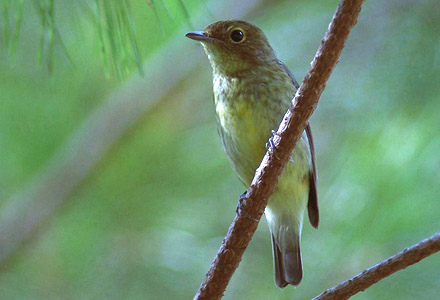
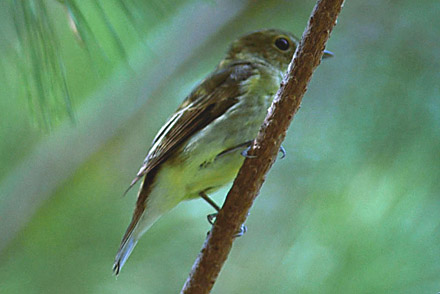
A different individual, photographed on Okinawa in November (Figs 19 and 20), appears even less like narcissina, and instead rather close to both zanthopygia and elisae (falling ‘in sequence’ with the owstoni individuals in Figs. 17 and 22), in showing an obvious yellowish wash to the heavily mottled underparts.
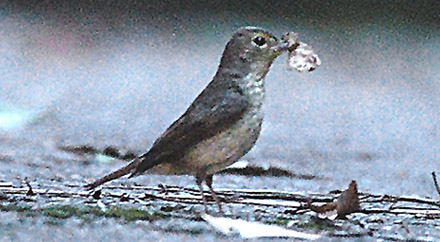
However, it also shows a clear yellow-toned eye-ring (ruling out both narcissina and zanthopygia), which is in addition more intensely colored above and paler lower (apparently unusual for elisae). Furthermore, perhaps unlike most elisae, the throat and breast are very heavily mottled with brown tips, with the yellow most prominent on the lower belly and vent.
An individual (Fig. 21) photographed in poor light, in Mid-May in Okinawa (and thus presumed likely to be an adult-type female owstoni) appears close to female narcissina, though it also still shows some brown mottling on the breast, yellowish tones to much of the underparts, and rather prominent yellowish on the “mock supercilum”, with even some yellowish tones to the upper part of the eye-ring, apparently ruling out female narcissina and making confusion with dull elisae rather more likely.
Second Calendar-year males
As noted above owstoni show great variety in appearance as Second Calendar-year males, with some appearing more like elisae, and others more suggestive of narcissina by spring of their second year.
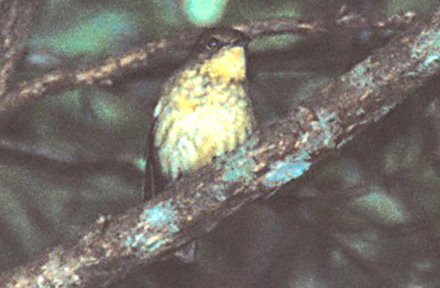
An individual (Figure 22) photographed in Iriomote (in the far south of the Nansei Shoto) in February for example, appears consistent with female-types photographed in November and May in Okinawa – in showing similar mottling on the breast sides, but an increasing intensity of yellow on much of the underparts, and especially on the throat (in some ways suggesting elisae), while an individual contained in the first edition 550 series (Ozawa, Yamagata and Yoshino, 2000), taken on March 18th (Number 7. p. 229), appears rather closer to both Fig. 18 and to (immature male/female) narcissina. Although it already shows e.g. obvious dark coming through on the ear coverts, it has very little yellow on its underparts. It is described by the authors as a male owstoni moving from First-winter into First-summer plumage, and it shows female-type upperparts (i.e. greenish, with two pale wingbars), but also patchy yellow on the rump, and a dark moustachial stripe-type pattern, forming the lower border to subtly darker ear coverts (both confirming its identity as a male). Of especial note, the 550 image also reveals a distinctive pattern on the median coverts, with bi-colored feathers (grey inner, black outer webs: cf Fig. 27), tipped rufous-brown (very similar both to the individual in Fig. 18 and to the birds on Gageo in 2001, Figs 28-30). Like many male owstoni it also shows yellowish lores, and an eye-ring toned strongly rusty-yellow above, whiter below.
Another two more advanced individuals, banded and photographed in southernmost Kyushu, Japan, at the end of April and in May were considered by the finder Tokorozaki Satoshi as best left unidentified on present knowledge – but based on criteria developed through study of other images, both of these are also believed by NM to be First-summer male owstoni.
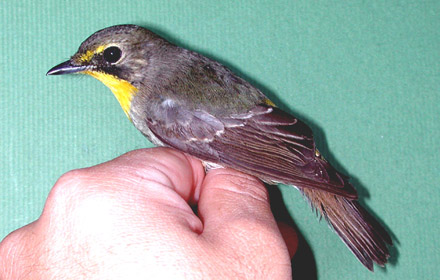
The first individual (Fig 23) shows a very odd mix of adult male-type and First-winter features (apparently typical of owstoni at this age). It also shows apparently freshly moulted-in, dull moss-green upperparts, contrasting both with worn grey-looking patches on e.g. the nape and with worn remiges and tail. Unlike Second Calendar-year narcissina (e.g. as in Figs 7-9), it shows no orange in the throat; shows yellowish feathering (admixed with greener feathering) near the nostril; has a trace of complex patterning in the median coverts (with one visible covert there again being half-black, half-grey); has full pale tips to the tertials (less prominent in female-type narcissina and already adult-type by this time); and also has an obviously short-looking primary projection (with only ca 7 fairly blunt-looking primary tips visible beyond the longest tertial). Although it shows a yellow rump band, this does not extend up the lower back as in many/most narcissina, and the ear coverts show an owstoni pattern of dark lores and lower ear coverts, with green above the dark, and extending round behind the eye.
A second individual, banded in May appears rather similar to that in Fig 23, but appears to have advanced rather further, assuming several more male-type features.
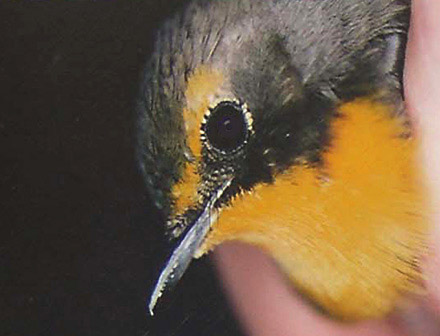
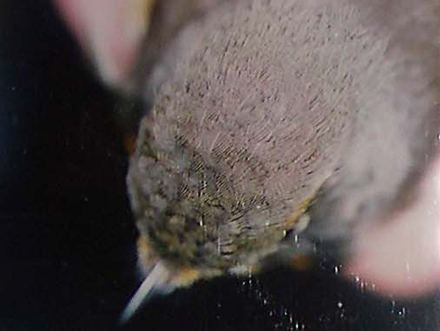
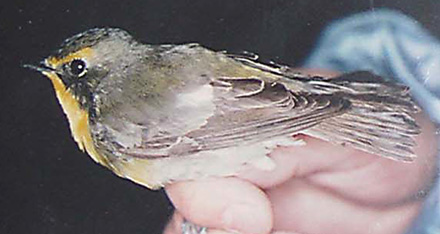
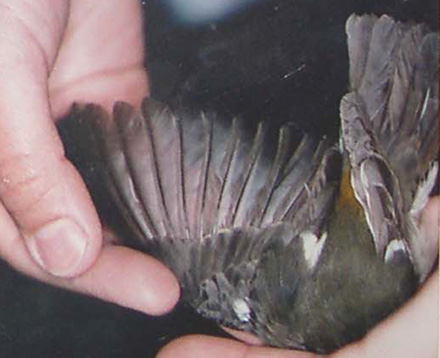
A close-up of the head (Fig 24) of the individual in Figs 24-27 reveals a few olive-green crown feathers, and yellow in the supercilium both extending back to the rear of the eye and also clearly forward to the (paler-based) bill, near the nostril. A view from above (Fig 25) shows these features even more clearly. It shows more extensive yellow on the underparts than the individual in Fig.23, with a small yellow rump-patch, and much more obvious white/pale on the inner greater coverts. A view of the spread wing (Fig 27) reveals very clearly the bi-colored median covert pattern (grey inner web, black outer) that seems to be typical of at least immature male owstoni.
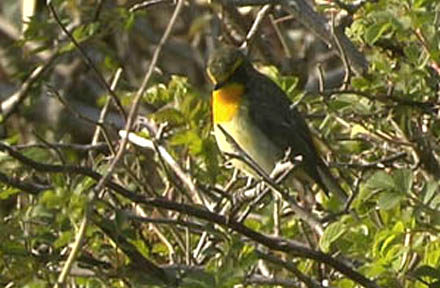
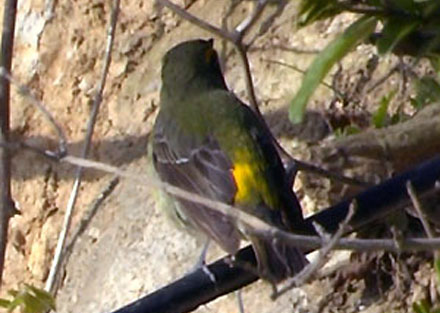
Close examination of the images taken on Gageo Island in late April, 2001 (Figs. 28-30) reveal obvious males, rather similar to those photographed in southern Kyushu in April and May. Both have moss-green upperparts, a half-formed yellow rump band, and a bright yellow throat, upper breast and supercilium (the latter extending across part of the forehead and on to the bill base, as in owstoni, and unlike narcissina). Both birds show two pale wing bars, and as noted at the time in individual one (and supported by images of both) some grayish wash on the lesser coverts and contrasting dark and grey centers to the median coverts, with median and greater coverts tipped off-white and brownish-rufous. In addition, both individuals show adult male-type ear coverts, with the second individual (Fig. 30) revealing the owstoni pattern of dark green above and behind the eye, and black below.
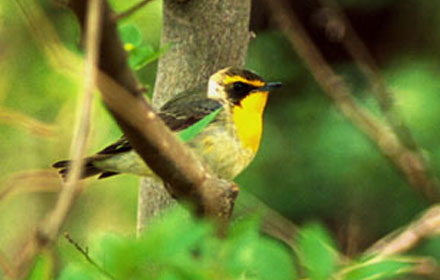
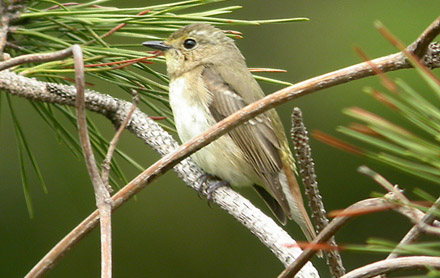
Considering (a) the features in this and other individuals, and (b) Otani’s (2002) assertion that some Second calendar-year males appear female-like in spring, then it also seems very likely that a female-type seen daily between May 9th and 11th 2000, on Gageo Island by NM, was also an owstoni. Although not documented with images, it was noted at the time as “strongly green” on the upperparts, had much broader and more prominent white on the closed wing than female-type narcissina, and its rump showed some yellowish-tinged feathers. Structurally, it was also obviously large-billed with an extremely short primary projection beyond the longest tertial (only ca 5 primary tips were clearly visible and counted beyond the longest tertial). A fairly similar-looking individual (also likely to be an owstoni), was photographed by NM on Eocheong Island on May 10, 2004 (Fig. 31).
Based on the lack of obvious yellow on most of the underparts and the lack of a yellow eye-ring, the individual in Fig. 31 is clearly not an elisae. Features strongly suggesting owstoni rather than narcissina include:
only 6 or more likely 7 primary tips showing beyond the longest tertial;
a rather heavy bill, slightly paler on the lower mandible towards the base;
strong green tones to the upperparts, with extensive yellow tips to feathers on the rump and most especially on the uppertail coverts (suggesting it can be aged as a retarded Second Calendar-year male – and much too retarded at this date for male narcissina);
contrast between the rusty tips to the outer coverts and the whiter inner;
yellowish tones on the throat and forehead, notably extending towards the nostrils;
yellowish tint to the upper half of the eye-ring;
apparently a hint of darker feathering coming through at the lower edge of the ear coverts, suggesting the beginning of a weak and broken moustachial stripe – a feature shown by many immature male owstoni (e.g. Fig.15) as they develop darker ear coverts, but not shown by e.g.female narcissina.
Identification summary
Owstoni
Short to medium primary projection, rather heavy bill, often with slightly paler bill base/lower mandible. Adult male plumage, acquired in Third Calendar-year, shows diagnostic combination of green tones to mantle, crown, and ear coverts to rear of and below eye (contrasting with blackish lower ear coverts). Colored supercilium reaches towards the nostrils. Second calendar-year males highly variable in appearance. In many, male plumage suggested by dark line on moustachial stripe, yellow flecks on rump, yellowish on lores. If clean and bright yellow on underparts present, strongest color is confined largely to the throat and breast (belly and vent paler). Some female-types said to resemble narcissina. At least some female-types show strong, dense mottling on breast sides (especially in First Calendar-year), with yellow wash on underparts. Some show complex internal patterning on the median coverts. Most show obvious contrast in the tone of the tips to the greater coverts. Eye-ring variable, often two-toned, yellowish or greenish upper, paler lower.
A link to discussion on the Hong Kong Birdwatching Society photo gallery pages sent on by Paul Leader in Hong Kong in late March 2006 contains an image of what might become the first record of owstoni Olive-backed Narcissus Flycatcher in Hong Kong: http://www.hkbws.org...PhotoGallery;action=display;num=1143710861
Elisae
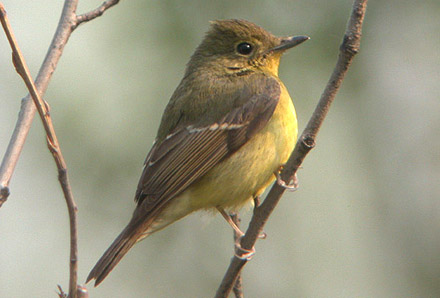
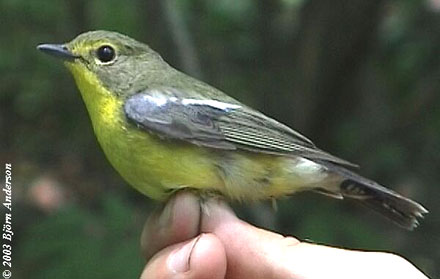
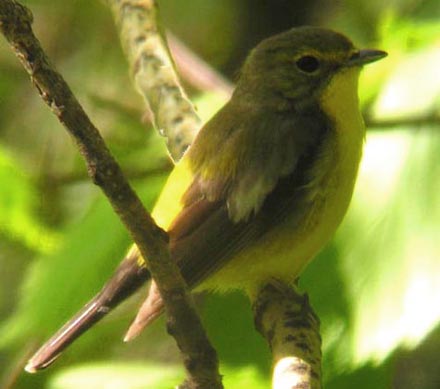
Images suggest that elisae is typically rather heavier-billed than owstoni and especially narcissina. Measurements and images of specimens suggest it is also slightly smaller in total length than narcissina (though differences might well be difficult to detect in the field), and further suggest that it shows typically ca 7 or 8 primary tips beyond the longest tertial – thus intermediate in primary projection between owstoni and narcissina.
Elisae is similar to some owstoni, but not narcissina or zanthopygia, in that obviously adult male plumage is acquired in the Third Calendar-year/Second-summer, with immature-plumaged (female-type) birds often noted in song. As a result considerable confusion remains over criteria for separating males and females, especially in their Second Calendar-Year.
In fully adult males the head and mantle are largely rather clean green (not so olivey-green or moss-green as in many owstoni), with an extensive yellow rump and prominent white on the inner greater coverts (the latter two features both absent in females), blackish or brown-toned flight feathers (often showing some greener edges, creating a light blaze on the closed wing), and a dark tail.
Apparently unlike owstoni (and contra Otani, 2002), adult male elisae lack obvious white on the tertials and seems often to show fairly distinctive and contrastingly plain grayish-centred lesser and median coverts. The underparts are washed through with a uniform lemon-yellow (of the same intensity and clean tone as the rump), though in some with cleanly contrasting whiter-looking undertail coverts.
There seems to be significant variety in the head-pattern (likely age-related?). While none show dark ear coverts and all show clear yellow lores and a strong yellow or yellowish-toned eye-ring (often evenly-colored, though see Fig. 33), others also show in addition a faint yellow supercilium (apparently occasionally matched by some First-summer male owstoni), while at least a few individuals also have a very prominent, long and thin yellow supercilium
(http://orientalbirdimages.org).
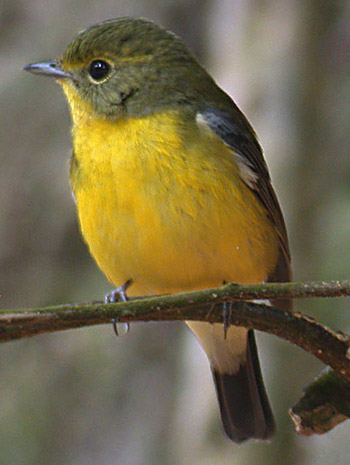
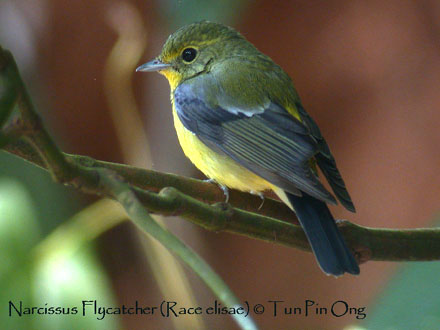
Female-types (Second Calendar-year males and females)
Zheng et al (2000) studied flycatchers found in forest near Beijing. Based on existing literature (cited in their paper), they considered some of these flycatchers to be immature elisae, but through collection they “found many times that some males have fully developed testes” while sonagrams made of songs of such individuals also “show remarkable differences” from e.g. narcissina.
This led them quite logically to conclude that the “type”, closely resembling plumage descriptions of immature elisae, was actually a new species of flycatcher, which they named Ficedula beijingnica (Zheng et al, 2000). They provide a full description of such males (which, in the absence of further information or correction, and based on more recent information on owstoni, are considered here to be First-summer male elisae): “The lore of the adult male is brown with lemon yellow; eye ring is pale lemon yellow. Upper parts of head, nape and the sides of neck are olive-green, the central part of the head feather are dyed with brown and forming the inconspicuous traces of squamation. Ear coverts are brown with some yellow thin shaft stripes. Back and rump are dark olive-green. Upper tail coverts are olive-green and edged paler. The outside of the tail is dyed with red brown. Wings dark brown, with the outer webs of remiges have red-brown edge; and the inner webs of the secondaries have white edge. The end of the tertials have pale white edge. Wing coverts are brown, the outer webs have a thin brown edge; the end of the greater and median coverts are white, forming two obvious white wing bars; axillaries and underwing coverts are paler lemon yellow; breast and flanks are suffused with olive green; undertail coverts is paler lemon-yellow”.
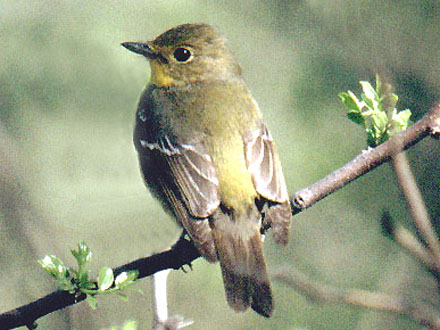
With information provided by Otani (2002) on the variation in plumages and the breeding of female-plumaged First-summer male owstoni, it is then much easier to accept the opinion that beijingnica is sadly and “definitely the first summer plumage of elisae” (Paul Holt, in lit., 2004). According to the account in Zheng et al (2000), there appeared to be no clear ecological difference between “beijingnica” and elisae, which occurred together in the same forest, and moreover the plumage features suggested diagnostic of beijingnica would be considered indicative of retained immature plumage in owstoni (e.g. lack of clear rump band, some traces of brown on the head, where still some mottling; reddish brown tail; brown wing coverts etc).
Adult female “beijingnica” (= Presumably Second Calendar-year elisae) is also described by Zheng et al (2000), as: “similar to the male, but the chin, throat to upper breast is more less suffused with inconspicuous traces of squamations”. In narcissina, owstoni and zanthopygia diffusely-patterned scalloping on the breast appears to be closely associated with age, suggesting that elisae showing obvious scalloping/squamations are likely Second calendar-year females – thus, in the same way as males, acquiring a less than fully adult plumage in First-summer. It also suggests, supported by the plates of specimens in Zheng et al. (2000) that most elisae in late spring/summer, whether male or female, should appear largely yellow below, and greenish above, making their separation from narcissina and most owstoni straightforward.
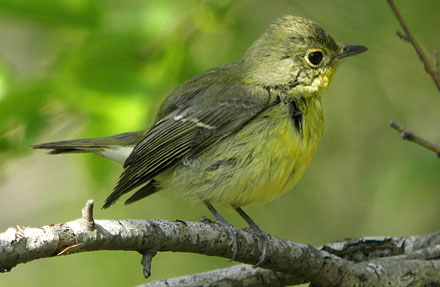
Note again the prominent yellow eye-ring, the clean yellow underparts with contrasting white undertail coverts, and the green-toned upperparts (with slightly brighter rump). The lack of mottling below suggests it is an adult, and sexing as female is suggested by the absence of a yellow rump-band, white on the inner greater coverts, or yellow in the lores. Instead it shows the strong white-tipped greater covert bar considered fairly usual in female elisae.
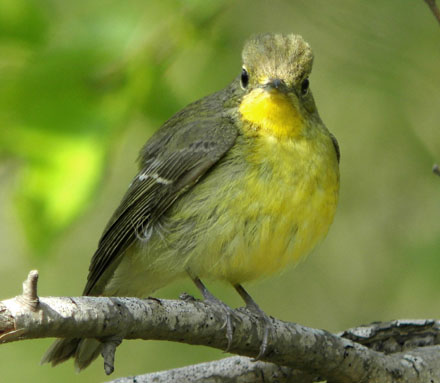
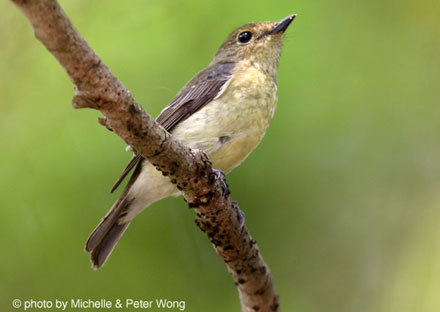
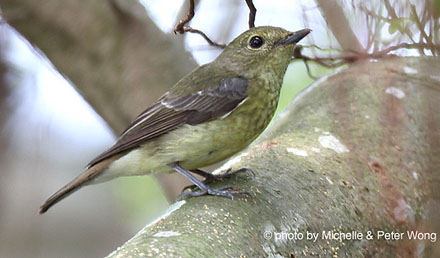
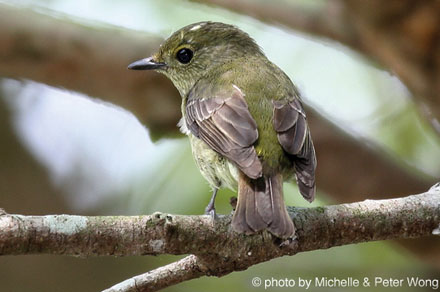
Although those elisae that are clean “green-backed” and smoothly yellow on the underparts are straightforward to identify to taxon, many elisae show quite dull underparts, with only faint yellow, instead being rather heavily mottled with brown (the “squamations” of Zheng et al, 2000), and therefore can be rather/very similar to owstoni. These are presumably all First-winter/retarded Second Calendar-years. In 2005, one observer saw at least 4 different elisae at Happy Island and Xialongmen (ca 120km west of Beijing within the known breeding area), and all were considered very dull, with only limited yellow on the underparts (Mathias Ritschard, in lit. 2005).
A female-type photographed in Hong Kong in April 2005 (Figs 40-42) can be aged as a Second Calendar-year as it shows both thin and worn tips to the wing coverts and rather sullied underparts - with fairly heavy scalloping forming a dusky brown wash especially across the breast, mixed with yellow, most intense on the lower belly, before fading to clean white on the undertail coverts. On the upperparts it appears rather similar to some female-type narcissina and especially to owstoni, with a grayish-olive green mantle, and it also shows a (female-type) strongly rufous-washed uppertail. Viewed from the rear, however, a very few brighter yellow feathers can be seen speckled on the rump, indicating the possibility this might well be a First-winter male, and this possibility is perhaps supported further by the shape of the greater coverts, with the outer greater coverts of equal length and width, and the inner greater coverts slightly longer and broader as in males.
Whether male or female, in addition to location, fairly confident identification of this individual as elisae can be based on e.g. the obvious yellow wash to the underparts (ruling out narcissina), with its well-demarcated whiter undertail coverts (not noted in images of owstoni); the extent of the mottling on the underparts (confined more to the breast-sides in owstoni); the fairly evenly yellow eye-ring (typically rather more two-toned in both owstoni and narcissina); the contrastingly grey and plain lesser and darker median coverts (latter often distinctly patterned in owstoni, coverts not so contrasting in narcissina); and on its structure - a combination of heavy bill and medium-length primary projection (with 7 or more likely 8 primary tips visible from the rear on the right wing).
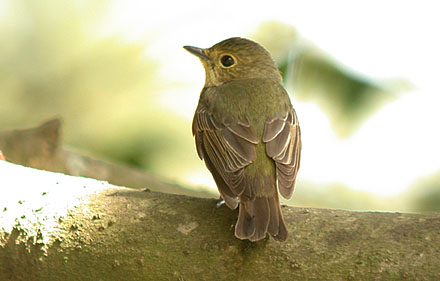
.jpg)
Based on the identification criteria for dull female-type elisae and for owstoni outlined above, a female-type (Figs.5, 43-44), photographed by Park Jong-Gil on April 24th 2005 on Heuksan Island, can be safely identified as elisae (to become the first documented record in Korea fully supported by images). This individual shows: (1) rather clean green upperparts; (2) dull, but strong yellow-buff underparts, without obviously paler undertail coverts but with a rather yellower and brighter throat (perhaps suggesting a male); (3) obviously contrasting grayish lesser and darker median coverts (lacking any complex internal pattern); (4) two weak wingbars, suggesting it can be aged as a Second calendar-year, with the innermost visible greater covert appearing slightly wider and longer than the row of outer ones (perhaps suggesting a male); (5) yellow-washed lores (suggesting a male); (6) a complete, bright, evenly-toned yellow eye-ring; (7) a heavy bill; and (8) ca 7 or 8 primary tips visible beyond the longest tertial (thus excluding owstoni). It can perhaps best be identified as a First-summer male elisae (an identification suggested first by Mathias Ritschard, in lit., May 2005, based especially on the cleanness of the yellow on the throat).
Identification summary: Elisae
Medium primary projection and heavy bill, only faintly paler on bill base and lower mandible. Typically, eye-ring prominent and evenly washed yellow (sometimes paler). Aging and sexing very complex. Adult males (Third Calendar-year onward) show unique combination of green mantle and head, with yellow lores, broad yellow rump band and clean-coloured yellow underparts. First winter males and Female-types show green-washed upperparts with warmer-toned tail, and extensive darker mottling on the underparts admixed throughout with yellow. By spring of the Second Calendar-year, many males show some obvious cleaner yellow on the underparts. Males are believed more likely to show cleaner yellow throat and more extensive pale on the inner greater coverts in Second calendar-year than females. Adult females are clean yellow below, and can apparently show rather prominent white-tips to the greater coverts.
Zanthopygia
Zanthopygia is included here for completeness, as some individuals, particularly in autumn, might be confused with (especially) owstoni and (some) elisae. It is though a rather plump-looking species, often looking fuller- and deeper-bodied than narcissus-types, with a rather heavy bill, and long primary projection.
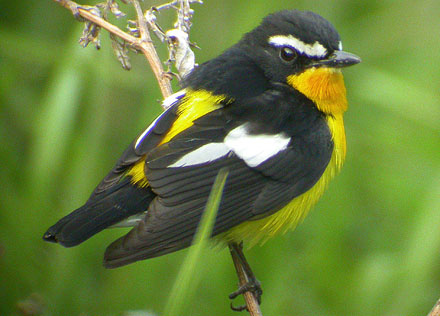
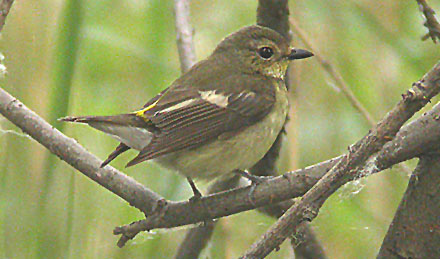
Unique among the taxa covered here, not only adult males but also females and First-winters are yellow-rumped. In addition, both males and females show very extensive white on the inner greater coverts, with much of the outer web of the lowest tertial also white, appearing as a very obvious “spur” on the wing. Although some narcissina can show some white at the base of a tertial, and owstoni often shows a more obvious white spur, neither typically approach zanthopygia in this respect.
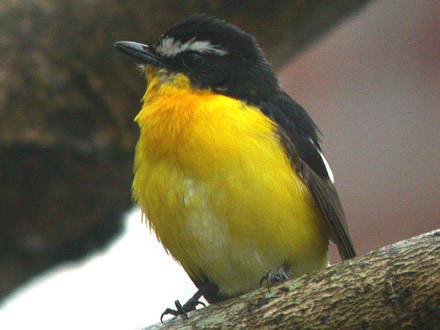
Zanthopygia First-summer males (and presumably females) closely resemble full adults by early spring of their Second calendar-year. The main age-related differences in Second Calendar-year males are that the throat is less vividly orange than in breeding-plumaged adults; the underparts less smoothly yellow; and the flight feathers appear brown, worn and contrasting with the glossy black wing coverts and the upperparts. Occasionally, a few brown flecks are still visible on the head or intermixed in the mantle. In all males, the supercilium is well-marked, often flared-looking, and white (often with some yellowish flecks intermixed).
Some juveniles (e.g. in August or September) show an elisae-or owstoni-like combination of yellow-washed underparts (often rather mottled looking) with a plain head, prominent eye-ring, and two wing-bars formed by paler tips to both the median and the greater coverts. However, even at this age, they show rather prominent white across the innermost greater coverts, and some white on the lowest tertial. Additionally, rear views should also reveal the broad yellow rump patch, not shown by similar-plumaged owstoni or elisae.
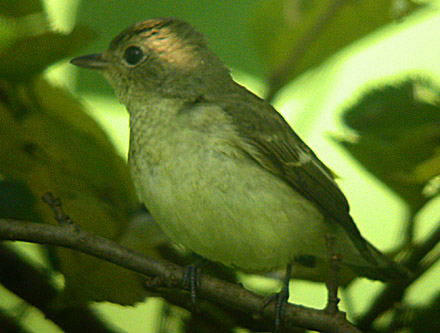
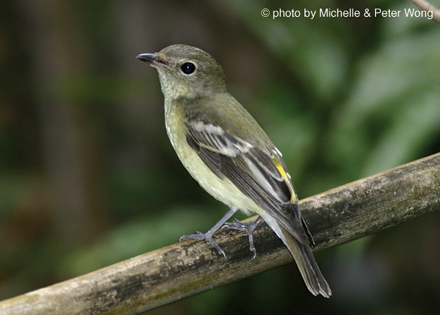
A Note on Vocalisations
Increasingly, narcissina, owstoni and elisae are considered to have markedly different songs (e.g. Zheng, 2000; Otani, 2002; Crystal in lit., 2004; Nakamichi in lit. 2005). Sonagrams in Zheng et al (2000) appear to show significant differences between the songs of narcissina and ‘beijingnica’(= elisae); and Otani (2002) reports that the song is “the most significant feature” for separating owstoni and narcissina.
The song of owstoni comprises shorter and simpler phrases than narcissina (as also reported by Fergus Crystal from Iriomote, in lit. 2004, and Nakamichi Akiyo in lit., 2005), and Otani (2002) also reports negative response resulted from playback of narcissina song to owstoni and vice-versa. In addition, a recording of singing elisae (made in China) played to two singing narcissina in Fukuoka, Japan (June 1997) produced no response, though the same two individuals responded aggressively to both playback of their own songs and to a commercial recording of narcissina made in Japan (NM pers.obs).
Despite this, further research is perhaps still required throughout the ranges of these three taxa to establish which differences are genuinely taxon-based, and which are products of individual variation, age, and even dialect. Personal experience of singing narcissina in Japan, for example, suggests that there is wide variation between individuals, with at least some of this variation likely linked to age (First-summers apparently being less varied singers than full adults), month (with the most varied and energetic songs, rich with apparent mimicry, most often heard in late April and early May), and even time of day (with often only the most basic phrases repeated during the hottest part of the day). It also seems likely, based on subtle differences between the “rattle” calls of other Ficedula species, that such calls will also vary between the taxa.
We are extremely grateful to Swiss-based Mathias Ritschard for providing the following recordings of elisae.
elisae call 1 (mp3 file) (597kb) © Mathias Ritschard
elisae call 2 (mp3 file) (193kb), Happy Island, May 2005. © Mathias Ritschard
elisae song (mp3 file) (980kb), 2cy bird, Xialongmen NFR (National Forest Reserve), Beijing Province, May 2005. © Mathias Ritschard
For two recordings of owstoni in song, please go to the web-pages run by Nakamichi Akiyo at:
nikonf.hp.infoseek.co.jp/f6hs
Gaps in Knowledge (including some related observations on Taxonomy)
It is clear that narcissina, owstoni, and elisae (and zanthopygia), are:
distinctive in male plumage;
likely distinctive in female plumage;
show significant differences in moult strategies;
apparently show consistent differences from each other in structure/biometrics;
have discrete breeding and non-breeding areas, with different ecological requirements (as they occupy significantly different breeding habitat);
are considered to have different songs.
So why are only narcissina and zanthopygia widely regarded as full species?
Firstly, East Asia can be considered a region that in general remains rather conservative in its approach to taxonomy, while “over the past half-century or so other parts of the world have advanced much further in taxonomic matters, with a greater number of workers focusing on avian systematics and a concomitant greater number of species being identified for their regions” (Collar, 2003).
By way of example, the two “subspecies” of Red-breasted Flycatcher Ficedula parva parva and F. p. albicilla have been regarded by the British Ornithologists Union Records Committee (BOURC) as two full species since 2004, while the confusingly similar-looking black-and-white Ficedula of the Western Palearctic (Pied F. hypoleuca, Collared F. albicollis and Semi-collared Flycatchers F. semitorquata), were first divided into three species and have now been split into four, with the BOURC recently also recognising the Atlas Flycatcher Ficedula speculigera of North Africa (BOURC, 2004) as a full species. While identification of most breeding-plumaged males of these four ‘black-and-white flycatchers’ is fairly straightforward (though still much less so than in the case of adult male narcissina, owstoni and elisae!), field identification of female-types and First-winters is largely based on very subtle differences.
Secondly, several significant gaps in knowledge about narcissina, owstoni and elisae remain, due to a combination of their rather secretive behavior, limited information exchange within the region, and poor representation in field-guides. Whilst East Asia and the Oriental region is undoubtedly the center of Ficedula diversity (with for example twelve species already listed in China alone by Mackinnon and Phillipps, 2000), few observers here have knowledge of all three of these taxa, and their similarities have been overly stressed in preference to their differences.
If existing but scattered information was brought together and reappraised, it would surely prove invaluable to a much-needed taxonomic re-evaluation. This in turn would surely encourage further field studies and conservation initiatives.
Questions to be answered
Despite the recent advances in understanding, much still remains to be confirmed about these taxa. Among key questions that still remain (and for which Birds Korea would especially welcome feedback):
Genetics: Have any studies been conducted? What were the conclusions?
Identification: Are there any other diagnostic features that are detectable in the field with good views? Is there much variation in e.g. number of exposed primaries beyond the longest tertial in these three taxa (and within e.g. owstoni)? Is the pattern of the median coverts a good feature for owstoni? Is it applicable to both males and females? Is the typically even-toned yellow colour of the eye-ring in elisae diagnostic? Are the vocalizations reliable for identification?
Ranges: Does owstoni breed outside of the Nansei Shoto, and if so where? Do any of these taxa breed sympatrically (and if so, what happens where they meet?). Has narcissina been recorded with any regularity in Malaysia and Thailand? Where is its main wintering area (if not in the Philippines)?
Ecology: What are the main differences in habitat choice, in breeding and wintering ecology between these taxa?
Conservation: What are the main causes of the apparent scarcity of owstoni and elisae? Have population estimates been made? Are there protected areas or management plans in place for any key areas for these taxa? How much of an impact is deforestation having on narcissina? How can any declines be reversed?
Summary
The Narcissus Flycatcher Ficedula narcissina, is presently considered to contain three distinctive subspecies – nominate narcissina, owstoni and elisae.
Although adult males of the three taxa are rather straightforward to identify, female-types (as in many other Ficedula species) are considerably more problematical, and well-established identification criteria seem to be lacking. This has led to many individuals away from mapped breeding areas remaining unidentified, and also contributed to significant confusion in relation to their distribution and even taxonomic status. This online paper therefore first reviews information on distribution (with a special focus on South Korea) and concludes that on present knowledge the three taxa can be considered very largely to both breed and winter allopatrically.
Second, through the use of images and description the paper proposes a set of identification criteria for use in the field. In the more difficult female-type plumages, the easiest criteria appear to include primary projection; upperpart and underparts tones (including the extent of brown mottling and yellow wash); the pattern especially on the median coverts and the tips of the greater coverts; and the colour of the eye-ring. These features are highlighted in the tables in the Appendix (below the References).
If these criteria are accurate as believed, they clearly support the first records of both owstoni and elisae for South Korea.
It is believed, however, that although much material on these taxa probably exists (and perhaps simply awaits sharing and more detailed and methodical analysis), further research should still be conducted to establish more clearly the parameters and the ecological requirements of each taxon.
There is some urgency about such research. Both elisae and owstoni are likely species of Special Conservation Concern, and even narcissina is likely affected by region-wide deforestation.
In a region of high human pressure and few resources for bird conservation, it seems likely that full recognition of the Black-backed, Olive-backed and Green-backed Narcissus Flycatchers (if warranted) could help to attract research and funds, and ultimately assist in their conservation.
Acknowledgements
Although still obviously incomplete, this paper has benefited enormously from very welcome input from a large number of people throughout this region and beyond.
Many thanks go to: Park Jong-Gil here in South Korea, for his very kind sharing of his images of the Heuksan elisae; Fergus Crystal for the analysis of his own field studies, and with Sean Minns, for their detailed mailings to Birds Korea and Kantori; in Taiwan, Wayne Hsu, who provided information and links to images, and his grandfather, Chuan-Chiung Chang, who kindly permitted the use of his images of both owstoni and narcissina; Nick Lethaby and Mark Brazil; Krys Kazmierczak and Atle Ivar Olsen for both drawing attention to Otani Chikara’s extremely important note in the Oriental Bird Club Bulletin, and also for making such great efforts to make it accessible; also to Krys for the images accessed through the excellent Oriental Bird Club Images, and Atle for his video-grabs and notes on narcissus-types in the Nansei Shoto.
Many thanks also to Des Allen, for many good leads, and to Paul Holt for his comments (and for his gathering information on elisae, increasing attention on this threatened taxon). Many thanks are also respectfully given to Yanyun Zhang – in the knowledge that their research is key to understanding and conservation, and to Mathias Ritschard, one of the finders of Korea’s first claimed elisae.
The paper and the criteria are based around many stunning images, provided with great kindness.
Thanks to Jon Hornbuckle, and in Japan, many, many thanks to Akiyo Nakamichi and Ikenaga Hiroshi for making such great efforts to secure wonderful images of owstoni from Takehara Kenji and Hashimoto Kozo in Okinawa, Miyagi Yasuko in Ishigaki-Jima, Aoki San in Oita Ken, and Satoshi Tokorozaki in Kagoshima Ken (identification as owstoni being the responsibility of NM, and not of the photographers, as explained in the captions); also Katsuyuki Kon in Honshu for his superb portrait of a narcissina. Many thanks to visiting birders who allowed use of their images from Japan (including Pete Morris of Birdquest, who very generously allowed use of his superb owstoni images), and from Hebei in China: Nils van Duivendijk, for an excellent series of images of elisae and comments on their identification; Mike Parker; Bjorn Anderson; Bjorn Johansson, and for his very helpful comments; Don Roberson (montereybay.com/creagrus/muscicapids); Steve Arlow (and for sending one more image than was hoped for!). From further south, in Hong Kong, many thanks also to Peter and Michelle Wong for their stunning images of elisae and also zanthopygia and for images from Malaysia, many thanks are due to Susan Wong Chor Mun, Christian Artuso (in Canada), and for those incredible shots by Tun Pin Ong.
Again, to all: many and continuing thanks.
(A mail from Dr. Per Alstrom in August 2005 stated that he, Urban Olsson, Yoshimitsu Shigeta and Paul Holt have been "working on a manuscript on the taxomony of these birds for many years that we’re hoping to complete this year. " As such, it can be hoped that many of the questions raised by our online paper will soon be answered.)
References
- BOURC (2004) in Ibis 146: 153-156
- Brazil, M. (1991). The Birds of Japan. Helm.
- Chalmers. M. (1986) Annotated Checklist of The Birds of Hong Kong. Fourth Edition. Published by the Hong Kong Birdwatching Society.
- Collar, N. (2003). How many bird species are there in Asia? Oriental Bird Club Bull. 38: 20-30.
- Holt, P. (2004). Request for help
- “Chinese” Narcissus Flycatcher Ficedula narcissina elisae
. BirdingAsia 2: P.8 (2004) - Ozawa H., Yamagata, N. & T. Yoshino. (2000). Nihon no Tori 550 San Ya no Tori.
- Ishimoto, K. (2005). Some New Records of Birds in Shimane Prefecture from 1998-2003. Bull. Hoshizaki Green Found. (8): 303-306, Mar. 2005 (in Japanese with English abstract).
- Lee, W-S, Koo, T-H. & J-Y Park. (2000). A Field Guide to the Birds of Korea. LG Evergreen.
- Mackinnon, J. & K. Phillipps. (2000). A Field Guide to the Birds of China. Oxford University Press.
- McWhirter D., Ikenaga, H., Iozawa H., Shoyama M. & K. Takehara (1996). A Checklist of the Birds of Okinawa Prefecture, with Notes on Recent Status including Hypothetical Records. Bull.of Okinawa Prefectural Museum, Volume 22: 33-152, (1996). Online at: http://www1.accsnet.ne.jp/~ikecho/OKINAWA/Okinawa.html
- Morioka H., Dickinson, E. C., Hiraoka T., Allen D. & T. Yamasaki (2005). Types Of Japanese Birds. 2005.3. National Science Museum Monographs No. 28. National Science Museum, Tokyo.
- Otani, C. (2002). Little-known and neglected distinctive (sub)species of southern Japan. Oriental Bird Club Bull. 35: 26-31.
- Petersson, B., Parkas J., Vattulainen, M. & P. Dernjatin. (2005: unpublished report). A tour to East China Sea and Zhejiang province, China 15 April – 4 May 2005
- Robson, C. (2000). A Field Guide To the Birds of South-East Asia. New Holland publication.
- Wild Bird Society of Japan (1982). A Field Guide to the Birds of Japan. Kodansha International.
- Zheng, G., Song, J., Zhang, Z., Zhang, Y. & D. Guo. (2000) A New Species of Flycatcher (Ficedula) from China (Aves: Passeriformes: Muscicpaidae). Journal of Beijing National University (Natural Sciences). June 2000, Vol. 36, No. 3.
Appendix:
Tables with Summary of Identification Features of the narcissina Black-backed, owstoni Olive-backed and elisae Green-backed Narcissus Flycatchers
Table 1: Structure
| narcissina | owstoni | elisae | |
| Primary Projection | Very long (8-9 tips visible) | Rather short (5-7 tips visible) | Medium-length (7-8 tips visible) |
| Bill | Not heavy, dark | Heavy, a little deep; often rather paler at bill base | Rather heavy, dark, sometimes slightly paler bill base. |
Table 2: Full Adult males
| narcissina | owstoni | elisae | |
| Eye-ring | Not prominent | Not prominent | Prominent, Yellow |
| Mantle and crown | Black | Variable: Moss- or Olive-green to blackish-green | Green |
| Rump | Orange-amber (extending up to lower back) | Amber-yellow (narrower than in narcissina) | Lemon –yellow (narrower than in narcissina) |
| Supercilium | Yellowy-orange; distinct. Not reaching bill base | Yellow; distinct. Reaching to bill base. | Usually indistinct; if distinct, reaching bill-base |
| Ear Coverts | Black | Bi-colored: Green upper, black lower | Green |
| Lores | Black | Blackish | Yellow |
| Throat | Fiery orange (breeding); warm amber (non-breeding) | Amber yellow (breeding); yellow (non-breeding) | Yellow |
| Underparts | Orange, fading to amber, to yellow to white | Yellow (with yellow or whitish lower belly and undertail coverts) | Evenly yellow (with yellow or whitish undertail coverts) |
| Tertials | Occasionally some trace of white at base | Some contrast. Often fairly prominent white marking on lowest tertial | No white |
Table 3: Second Calendar-Year male (March-)
| narcissina | owstoni | elisae | |
| Eye-ring | Like adult, not prominent. | Variable. Eye-ring sometimes prominent and yellowish; sometimes closer to Full adult. | Prominent and yellow. |
| Upperparts | Similar to full-adult; some brown mottling on e.g. nape; retained brown wing coverts and remiges etc. White on inner greater coverts as adult.. | Highly variable: either greenish, with yellowish lores and forepart to supercilium, or closer to Full Adult, with darker ear coverts etc. . | Some variation. Green; typically lacks obvious white on inner greater coverts. . |
| Underparts | Orangey throat; white belly and vent, streaked yellow. | Highly variable. Intense yellow, if present, confined to throat and breast. | Variable. Either mottled brown and yellow throughout, or more intensely yellow throughout. |
Table 4: Female-Types
| narcissina | owstoni | elisae | |
| Eye-ring | Rusty above; whiter below; fading paler. Whitish in spring. | Greenish-grey to yellowy-green above whiter below; fading paler. Whitish in spring. | Bright Yellow, yellow-cream in some immatures. |
| Mantle | Brown, sometimes olive tinge. | Green- or olive-tinged. | Green; sometimes duller. |
| Underparts | Buffish-brown; warmer flanks in autumn fading paler - off-white by spring. Faint mottling below. Rarely some yellowish mottling. | Buffish-brown, perhaps fading paler in some (adult females). Heavy mottling on breast sides in some; in some (males?) weak yellow-streaking or more clearly yellow wash. | Buffish, with varying extent and intensity of mottling and/or yellow. Fully adult females probably rather clean yellow. |
| Greater Coverts | Rusty-tipped, fading paler; very little contrast if any between outers and inners. | Rust-tipped outers, whiter inners (only males?). | Rusty-tipped, fading paler; some contrast between browner outer and white tips to inner. |
| Median coverts | Plain, dark grey, with rusty tips fading paler; no contrast with greater coverts. | Often (only males?) with variegated internal pattern of grey and black, with broad rusty tips. Contrast with greater coverts. | Plain grey, forming indistinct patch on wing by spring, contrasting with lighter grey lesser coverts. |
613-762 부산광역시 수영구 남천2동 148-22번지 3-1108 호
Tel: 051-627-3163 Fax: 051-627-3164



